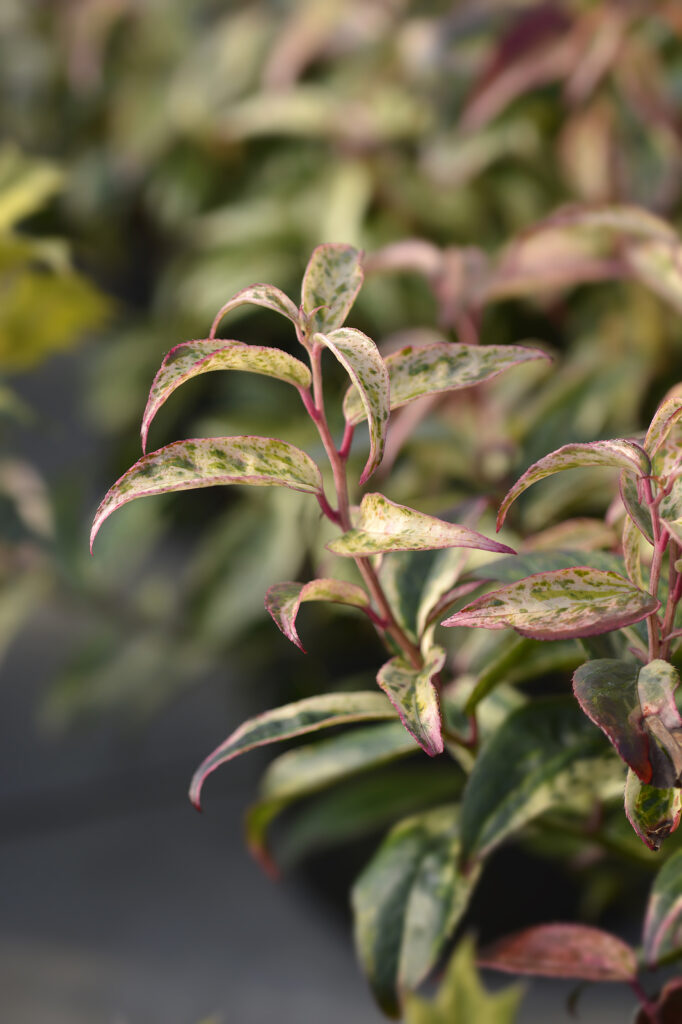Leucothoe — commonly called drooping Leucothoe –is a small to medium-size shrub that bears clusters of urn-shaped white flowers. Flowers bloom in racemes.
Leucothoe has a graceful, arching shape, with branches of some species forming zigzags. Leucothoe shiny, leathery leaves are frequently colored bronze or purple in spring or fall.
Leucothoe is effective in areas where its shape and flowers can be appreciated. It is a natural addition to a woodland garden.
The Leucothoe genus includes about 45 species of evergreen and deciduous shrubs native primarily to wetlands and woodland in the United States and Japan. About a half dozen species are commonly used in gardens.
Get to know Leucothoe
- Plant type: Evergreen shrub in the South; semi-evergreen in the North.
- Growing zones and range: Zones 5 to 8.
- Hardiness: Hardy to Zone 5
- Height and width: Up to 6 feet (1.8m) tall, but looks best when kept shorter.
- Foliage: An upright growing shrub with arching branches; some species form a zigzag branch pattern; shiny leathery green leaves turn a beautiful purple-bronze in fall.
- Flowers: Clusters of .25 inch (.6cm) wide, cylinder-and-urn-shaped, waxy white flowers that form in racemes.
- Bloom time: Spring
- Uses: Woodland planting or shady shrub border. Good for facing down rhododendrons and other larger relatives, or for rock gardens, on slopes, or as edging to help define paths.
- Garden companions: Sargent juniper (Juniperus sargentii)
- Common name: Drooping Leucothoe
- Botanical name: Leucothoe
- Family name: Ericaceae
- Origin: Woodlands and swamps in North and South America

Where to plant Leucothoe
- Plant Leucothoe in light to deep shade.
- Plant Leucothoe in well-drained, acidic, humus-rich soil that has been well amended with organic matter.
- Leucothoe does not tolerate drought, heat, drying winds, or soggy soil.
When to plant Leucothoe
- Sow Leucothoe seed in the spring.
- Set out container-grown plants in spring or autumn.
Planting and spacing Leucothoe
- Space Leucothoe 5 feet (1.5m) apart.
- Leucothoe are best used in masses, since they are not especially attractive individually.
How to water and feed Leucothoe
- Keep the soil evenly moist for Leucothoe, but never soggy.
- Feed Leucothoe with an all-purpose organic fertilizer in spring.
How to care for Leucothoe
- Leucothoe can be controlled in height to 1.5 feet (.5m) as a ground cover in shade. Just cut older, taller stems to ground.
- Cut Leucothoe back hard after they flower.
- Leucothoe does not tolerate drought, heat, drying winds, or soggy soil.
Leucothoe pests and diseases
- Leucothoe can develop powdery mildew, anthracnose, and tar spot.
- Leucothoe is susceptible to scale and lace bugs.
Leucothoe propagation
- Sow seeds in a cold frame in spring.
- Chip off Leucothoe rooted suckers in spring.
- Take Leucothoe soft cuttings in summer.
Leucothoe varieties to grow
- Leucothoe axillaris, coast Leucothoe: evergreen, native to southeastern U.S.; spreading, arching growth to 2-4 feet (.6-1.2m) tall, 3-6 feet (.9-1.8m) wide with long drooping stems in spring; needs regular water; best in Zones 6 to 8.
- L. davisae, Sierra Laurel, evergreen, native to wet places in mountains of the Far West. Upright shrub to 3.5 feet (1.4m) high. Oblong or egg-shaped, glossy rich green leaves to 3 inches (7.6cm) long. White flowers in erect 2-4 inches (5-10cm) clusters in summer. Needs ample water.
- L. fontanesiana (L. catesbaei), doghobble or fettlebush: drooping Leucothoe, evergreen, native to southeastern U.S., slow grower to 2-6 feet (.6-1.8m) high; branches arch gracefully forming a fountainlike shape.; leaves are leathery, 3-6 inches (7.6-15.2cm) long; they turn bronzy purple in fall (bronzy green in deep shade); spreads from underground stems; blooms in midspring, bearing drooping or dangling clusters of slightly fragrant, creamy-white flowers resembling lily-of-the-valley on 3 inches (7.6cm) racemes; drooping Leucothoe must have shade in the southern portion of its range; it is sometimes pruned as ground cover; this is the most commonly grown species Leucothoe. Zones 5 to 8. Cultivars include: ‘Nana’ grow 1-2 feet (.3-.6m) tall; ‘Rainbow’ (also known as ‘Girard’s Rainbow’) has green leaves with cream and pink markings that are especially noticeable in spring. 3-4 feet (.9-1.2m) high, has leaves marked yellow, green, and pink; ‘Lovita’ leaves are brilliant red on expanding, deep green in summer, and deep red in late fall and winter; ‘Scarletta’ has red-purple in spring that turn green in summer.
- L. Keiski, Cothoe: dwarf evergreen from Japan with red spring growth, turning purple-red in fall, and large flowers that bloom in early midsummer.
- L. populifolia, Florida Leucothoe, now reclassified in the Agarista genus with two natives in Brazil, this species is still usually sold under its former name; it is an evergreen native from South Carolina to Florida, it has especially graceful drooping branches; it can grow 8-12 feet (2.4-3.6m) tall, it tolerates severe pruning; new reddish growth turns rich, glossy green. In the humid South, it resists leaf spot better than other species do; fragrant flowers droop from leaf axils in late spring. Tends to sucker; a good choice for shady banks. Zones 7 to 9.
- L. racemosa, sweetbells: deciduous, native to southeastern U.S.; grows 3-8 feet (.9-2.4m) tall and wide, with 3 inch (7.6cm) slightly toothed leaves that turn red before dropping from their red stems; cylindrical white flowers in one-sided 3 inch (7.6cm) clusters that form at ends of branches in late spring or early summer; a pink flowering form is available; endures dry shade; best in Zones 5 to 9.















